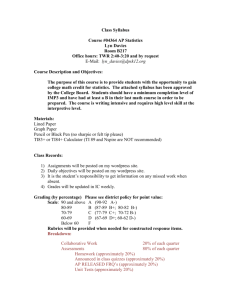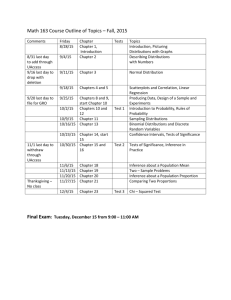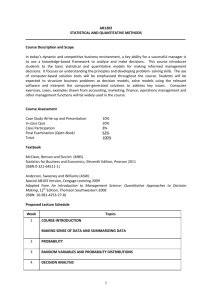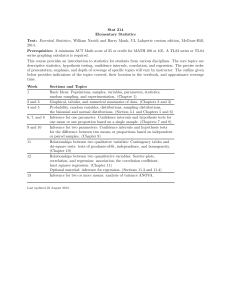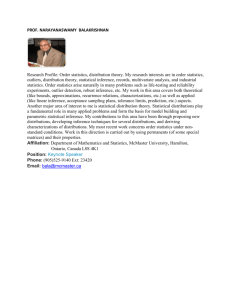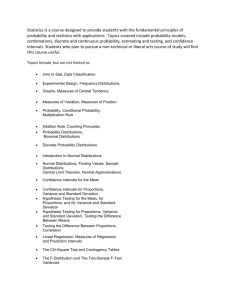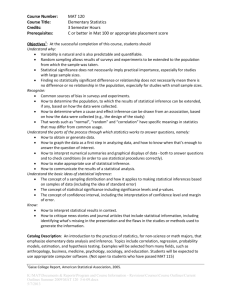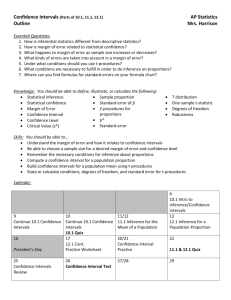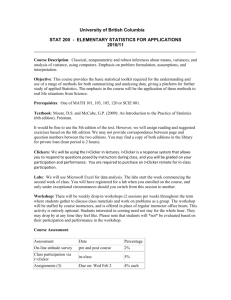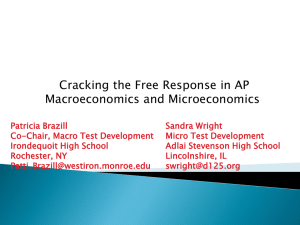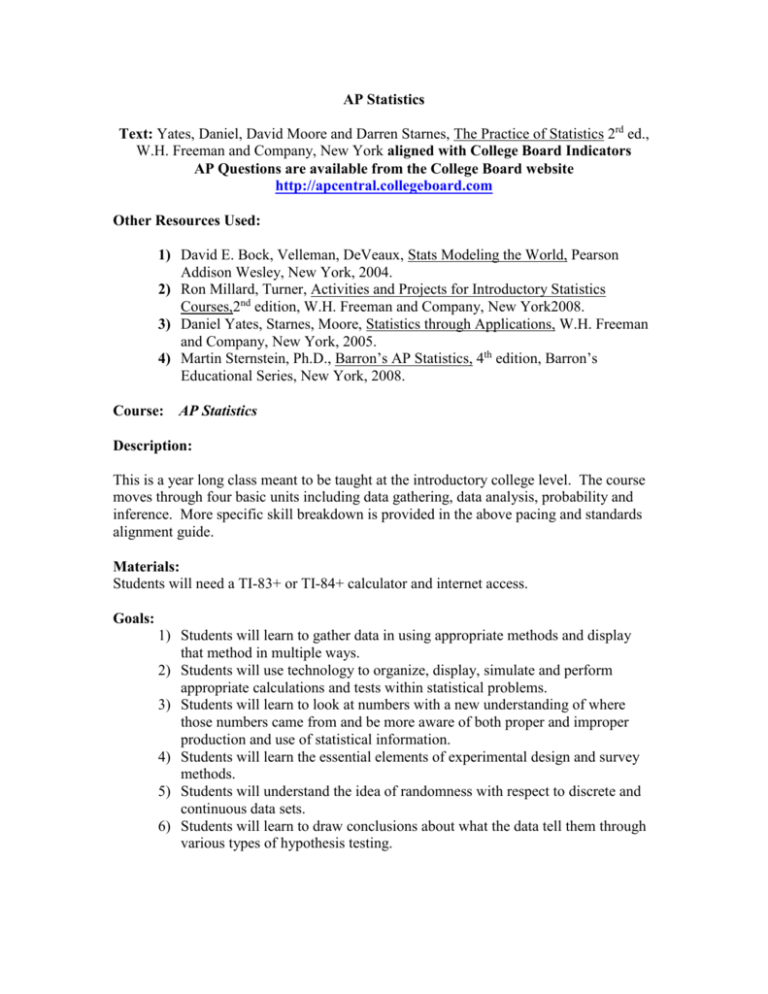
AP Statistics
Text: Yates, Daniel, David Moore and Darren Starnes, The Practice of Statistics 2rd ed.,
W.H. Freeman and Company, New York aligned with College Board Indicators
AP Questions are available from the College Board website
http://apcentral.collegeboard.com
Other Resources Used:
1) David E. Bock, Velleman, DeVeaux, Stats Modeling the World, Pearson
Addison Wesley, New York, 2004.
2) Ron Millard, Turner, Activities and Projects for Introductory Statistics
Courses,2nd edition, W.H. Freeman and Company, New York2008.
3) Daniel Yates, Starnes, Moore, Statistics through Applications, W.H. Freeman
and Company, New York, 2005.
4) Martin Sternstein, Ph.D., Barron’s AP Statistics, 4th edition, Barron’s
Educational Series, New York, 2008.
Course: AP Statistics
Description:
This is a year long class meant to be taught at the introductory college level. The course
moves through four basic units including data gathering, data analysis, probability and
inference. More specific skill breakdown is provided in the above pacing and standards
alignment guide.
Materials:
Students will need a TI-83+ or TI-84+ calculator and internet access.
Goals:
1) Students will learn to gather data in using appropriate methods and display
that method in multiple ways.
2) Students will use technology to organize, display, simulate and perform
appropriate calculations and tests within statistical problems.
3) Students will learn to look at numbers with a new understanding of where
those numbers came from and be more aware of both proper and improper
production and use of statistical information.
4) Students will learn the essential elements of experimental design and survey
methods.
5) Students will understand the idea of randomness with respect to discrete and
continuous data sets.
6) Students will learn to draw conclusions about what the data tell them through
various types of hypothesis testing.
College Board/
Indicator Ref. #
Text Section
1.0 Exploring Data
Chapters 1-4
Objectives: 1) Students will
become familiar with all major
types of data display including
bar charts, pie charts, dot plots,
line plots, stem and leaf plot,
boxplots and histograms.
2) Students will be able to
construct data displays
for quantitative variables
and will use TI-84
calculators to construct
histograms, boxplots and
scatter plots.
3) Students will be able to
choose and justify
appropriate summary
statistics for a data set
after commenting on the
shape, center and spread
of a distribution based
on the raw data and its
display.
4) Characteristics of
density curves with an
emphasis on Normal
Distributions will be
explored including
standardizing data and
the empirical rule.
5) Students will use normal
probability plots to help
justify the use of a
normal model.
6) Students will assess
linearity of bivariate
data by looking at a
scatter plot, residual plot
and calculating the
correlation coefficient.
7) Students will use
technology to generate
models for data
Days
Resources
(Time) AP Questions;
Vocabulary
In addition to the
44
text demonstrations
will be made using
Fathom software in
class.
Essential
Vocabulary:
Individuals
Variable
(categorical and
quantitative)
Distribution
Shape
Center
Spread
Outlier (know all
types and how to
test for them)
5 number summary
Mean
Standard deviation
Normal curve
LSRL
Residual
Correlation
Influential point
Conditional
Distribution
Simpsons’s paradox
including LSRL and
comment on those
models using the
coefficient of
determination and other
analysis.
8) Students will use models
to make predictions
about the data.
9) Students will use basic
functions to transform
data in order to improve
analytical potential.
1.1 a, b, c, d
1.2 a, b, c, d, e
1.3 a, b, c, d
3.3 a, b, c
1.4 a, b, c
Introduction pp. 4-10
Displaying data-charts
1.1 pp. 11-30
dotplots/stemplots/histograms
1.2 pp. 37-46
mean/5 number summary
1.2 pp. 49-61
spread-Standard Deviation
comparative distributions
2.1 pp. 76-91
density curves-normal dist.
68-95-99.7 Rule
2.2 p. 93-109
standardizing data/standard
normal curve
QUIZ #1
3.1 pp. 120-134
scatterplots-construction of
3.2 pp. 140-147
correlation
3.3 pp. 149-156
LSRL
3
3
3
3
3
3
3
3
3
AP: 2001 #6a;
2002B #5; 2003
#1a,b; 2006 #1;
2008B #1
HW 1: p. 34-36
#1.23-1.29 odd
AP: 2005 #1a
(choice of measure
of center)
AP: 2000 #3; 2001
#1; 2004B #5a;
2004 #1; 2006 #1
HW 2: p.66-70
#1.59-1.68 all
AP: 2007 #1a
HW 3: p.90-93 all
AP: 1998 #6a; 1999
#4a,c; 2002 #3a;
2004B #3a,b
HW 4: p.113-116
odd
HW 5: p.135-139
select problems
AP: 1998 #2; 2000
#1; 2002B #1
HW 6: p.146-149
select problems.
AP: 2006 #2
(regression line from
pp. 157-165
the role of r2
pp. 167-176
residuals
1.4 e
1.4 d
1.5 a, b, c, d
2.0 Sampling and
Experimentation
4.1 pp. 194-211
transforming relationships
log/ exponential models
pp. 214-222
power models
4.2 pp. 225-237
extrapolation/lurking variables
4.3 PP. 241-253
two way tables/conditional
distributions
TEST 1
Chapter 5
Objectives: 1) Students will
understand how to gather data
effectively by asking the key
question: What do we want to
discover?
2) Students will learn to
construct appropriate
survey questions to
answer questions about
a target population.
3) Students will learn to
model situations through
simulation techniques
using TI-84 calculators
and Fathom software.
4) Students will understand
the difference between
observational studies
and experiments.
5) Students will learn how
to determine the effects
of treatments on a
response variable
through experimental
software)
AP: 2005 #3
3
3
AP: 1998 #4
(residual plots);
1999 #6c; 2002 #4;
2003B #1(influential
points)
HW 7: p.176-190
select problems
3
3
3
2
16
HW 8: p.222-225
select problems
HW 9: p.238-240
select problems
AP: 1997 #6;
2004B #1
HW 10: p.257-261
even
Essential
Vocabulary:
Observational Study
Experiment
Population
Sample
Sampling
Census
Voluntary Response
Sample
Biased
SRS
Probability Sample
Stratified Random
Sample
Undercoverage
Nonresponse
Systematic Random
Sample
Convenience
Sample
Factor
Level
design.
2.1 a, b, c, d
2.2 a, b, c, d
2.3 a, b, c, d, e
3.1 e, 2.4
3.0 Anticipating
Patterns
5.1 pp. 268-285
observation v. experiment
sampling design: population,
census, voluntary response,
convenience, bias, SRS, PRB
sampling and stratifying
5.2 pp. 290-298
designing experiments:
Units, subjects, treatments,
factors, levels, placebo, controls,
randomization, replication,
significance
pp. 299-306
Blinding, matched pairs, block
designs
5.3 pp. 309-316 Simulating
experiments: random digit
assignment
Placebo
Randomize
Control
Replicate
Block
Blinding (double)
Probability Model
Simulation
4
6
4
3
QUIZ Chapter 5
Chapters 6-9
45
Objectives: 1) Students will
explore random behavior and
become familiar with the Law of
Large Numbers.
2) Students will learn basic
probability rules through
simulation and formal
methods.
3) Students will move from
AP: 2005 #5b,c;
2007 #5a
HW 11: p.285-289
all
AP: 2003B #3a;
2007 #2
HW 12: p.303-305
all
AP: 1998 #3; 1999
#3; 2000 #5; 2001
#4 (blocking); 2002
#2 (match pairs
design); 2002B #3;
2003 #4
(randomization);
2004 #2 (blocking);
2004B #2; 2006 #5
AP: 2003 #4a,b,d;
2007 #2b
HW 13: p.319-323
Part I of Project
Due
Essential
Vocabulary:
General Probability
Rules
Disjoint
Complimentary
Independent
Event
Outcome
discrete probability
calculation to theoretical
distribution models
including the normal
model, geometric model
and binomial model.
3.1 a
3.1 c
3.1 c
3.1 d
3.1 b, f
6.1 pp. 330-333 The idea of
probability
6.2 pp. 335-348
sample space, event, prb model,
Multiplication, Addition, and
Complement Rules
6.3 pp. 359-379
Conditional Probability-General
Rules
7.1 pp. 390-403
discrete/continuous random
variables, normal distributions
as PRB distributions
7.2 pp. 407-426
means and variances of random
variables, Law of Large
Numbers
Without
replacement
Discrete
Continuous
Expected Value
Binomial
Probability
Geometric
Probability
2
3
5
5
5
QUIZ Chapters 6-7
3.1 d
3.1d
2.2 a, b, c
8.1 pp.439- 461
binomial distributions
8.2 pp.464-475
geometric distributions
9.1 pp. 488- 502
HW 14: p. 356-359
all
5
5
AP: 1997 #3; 1999
#5; 2003B #2; 2004
#4a
HW 15: p.379-386
select problems
HW 16: p.403-405
all
AP: 1999 #5b;
2000 #6b,c; 2001
#2; 2002 #3; 2002B
#2; 2003B #5; 2003
#6a; 2004B #3c,d
(normal curve);
2004 #4b,c; 2005 #2
(expected values);
2006 #3a
HW 17: p. 427-430
select problems
AP: 1998 #6b,c,d,e;
1999 #4b; 2001 #3;
2004 #3 (conditions
for binomial
setting); 2006 #3b,c
HW 18: p.461-464
all
HW 19: p. 475-482
odd
3.4 a
3.4 b, c
4.0 Statistical
Inference
4.1 c, f
sampling distributions,
variability, parameters, bias
9.2 pp. 504 – 512
sample proportions
9.3 pp.514 – 525
sample means, central limit
theorem
TEST 2
Chapters 10 – 14
Objectives: 1) Students will use
sample statistics to estimate a
range of possible values for
population parameters
(confidence intervals).
2) Students will propose
models for situations
and examine observed
statistics to see if the
model makes sense.
3) Students will learn to
appropriately identify
and use inference
procedures to test
hypothesis based on the
central limit theorem
including tests about
proportions and means.
4) Students will learn to
check underlying
assumptions for all tests.
5) Students will know when
to use t models,
matched-pairs t models
and how to perform tests
on counted data.
6) Students will identify
understand and perform
inferences for
regression.
10.1 pp. 537 – 556 estimating
with confidence, confidence
intervals for a population mean,
margin of error
5
5
5
60
HW 20: p.499-504
select problems
HW 21: p.513-514
all
AP: 1998 #1
(CLT); 2004 #3c,d
(CLT); 2007 #3
HW22: p.525-530
all
Essential
Vocabulary:
Hypothesis
Null
Type I Error
Type II Error
Power
Significance Level
Standard Error
Pooled Data
Confidence Level
Inference
Margin of Error
P-Value
6
AP: 2007 #1c
HW 23: p.556-558
all
4.2 a, d
4.2a
4.2a
3.4 g, 4.1 f, 4.2 a, d
4.1 g, 4.2 e
4.1 d, 4.2 b
4.1 e, 4.2 c
3.4 h, 4.2 f
10.2 pp. 559 – 582
tests of significance, alternative
and null hypotheses, p-value,
statistical significance, onesample z statistic
10.3 pp. 586 – 592
statistical significance
10.4 pp. 593 – 605 inference as
decision, type I and type II
errors, power
QUIZ Chapters 8-10
Project Part II Due
11.1 pp. 616 – 642
inference for the mean of a
population, one-sample tstatistic, t confidence intervals
and tests of significance,
matched pairs t procedures,
robustness
11.2 pp. 648 – 668
comparing two means, twosample problems, difference
between means
12.1 pp. 685 – 697
inference for a population
proportion, confidence intervals
for p
12.2 pp. 702 – 713
comparing two proportions,
confidence intervals for
differences of proportions,
significance tests for differences
of proportions
Projects Due
13.1 pp. 728 – 743
5
5
6
6
5
5
3
3
AP: 2005 #5a
HW 24: p.583-586
select problems
AP: 2002 #1; 2002
#6a,b; 2003B #6;
2003 #6b,c,d
HW 25: p.602-612
select problems
AP: 2000 #2 (ttest); 2003 #1c;
2004 #6 (confidence
interval only);
2004B #5b,c; 2007
#4
HW 26: p.642-646
select problems
AP: 1999 #6a,b;
2000 #4; 2001 #5
(paired t-test or two
sample z test);
2002B #6a; 2003B
#4c; 2004B #4
(confidence interval
only); 2005 #6;
2006 #4
HW 27: p. 668-680
select problems
AP: 1998 #5;
2002B #4; 2003 32
(Type I and Type II
Error)
HW 28: p.698-701
odd
AP: 2000 #6; 2002
#5, #6c,d; 2003B
#3b; 2004B #6;
2007 #5
HW 29: p. 719-722
all
HW 30: p.742-744
4.2 f
Chi square test for goodness of
fit
13.2 pp. 744 – 766
inference for two-way tables,
chi-square statistic, chi-square
test for homogeneity of
populations
6
all
AP: 1999 #2
6
(independence);
2002 #6; 2002B #6b
(homogeneity);
2003 #5
(independence);
2003B #5c
TEST 3+ (Sample AP Exam)
(independence)
HW 31: p.766-775
select problems
4.1 h, 4.2 g
14.1 pp. 780 – 794
AP: 2001 #6b
regression inference, confidence 4
HW 32: p.806-811
intervals for the regression slope
select problems
Pacing based on 52 minute periods 5 days per week with approximately 165 prep
days before AP Exam.

